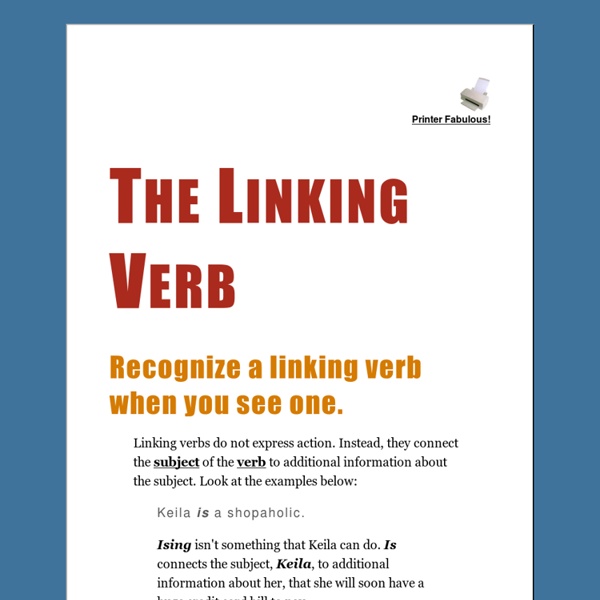The Linking Verb
Linking verbs do not express action. Instead, they connect the subject of the verb to additional information about the subject. Look at the examples below: Keila is a shopaholic. The following verbs are true linking verbs: any form of the verb be [am, is, are, was, were, has been, are being, might have been, etc.], become, and seem. Sylvia tasted the spicy squid eyeball stew. This substitution will not work for appear. Swooping out of the clear blue sky, the blue jay appeared on the branch.
Comparative and superlative adverbs | English Grammar Guide | EF
With adverbs ending in -ly, you must use more to form the comparative, and most to form the superlative. Examples The teacher spoke more slowly to help us to understand. Could you sing more quietly please? With short adverbs that do not end in -ly comparative and superlative forms are identical to adjectives: add -er to form the comparative and -est to form the superlative. Jim works harder than his brother. Some adverbs have irregular comparative and superlative forms. The little boy ran farther than his friends.
1.4e - Practice Distinguishing Adjectives & Adverbs
Is it an adjective or an adverb? The following guidelines will help you distinguish between adjectives and adverbs, and identify what they modify. Adjectives modify nouns and pronouns. They answer questions such as: which? how many? Adverbs modify verbs, adjectives, other adverbs, and sometimes whole sentences. how? An adverb can often move around more freely within a sentence than can an adjective, which is closely tied to what it modifies.
Adjectives or Adverbs?
Are you constantly confusing adverbs and adjectives? Well, we're here to cure your confusion for good. Think of adjectives and adverbs as answers to a question. Adjectives generally answer one of three questions about a noun: which one, how many, or what kind? Adverbs, on the other hand, tell us where, why, when, or how something happened. Two key points to remember 1. Example: Your hat is old. Example: It is old. 2. Example: He slowly walked to the store. Example: Jenny is clearly annoyed. Example: He walked very slowly. How can I identify adjectives and adverbs? The above explanations are all well and good, but you might be wondering how you can identify adjectives and adverbs just by looking at a sentence. 1. Your dog ate my baseball hat. At first glance, you might be tempted to say baseball is a noun, but upon closer inspection, we see that, in this case, the word baseball actually describes the noun hat. 2. If you’ll kindly give me my ticket, I'll be on my way. Exceptions
Grammar: Adjectives and Adverbs - Page 1
When using adjectives grammar rules apply. Also, when using adverbs grammar rules apply. Learn these rules in this free lesson. Adjectives and adverbs Adjectives and adverbs are both words that describe something. What is an adjective? An adjective is a word that describes a noun. Adjectives also make it easy to understand which thing you're talking about. What is an adverb? An adverb is a word that describes a verb. In the example above, the word deeply describes how he was staring, so deeply is an adverb. Using adjectives and adverbs You know adjectives and adverbs are both words that describe something. Look at the context If you're not sure whether to use an adverb or an adjective, try to figure out what you're describing. Adverbs, on the other hand, are used to describe verbs, which means they can explain how something happened, when something happened, or where something happened. Look at the ending You might have already noticed that many adverbs end with the letters ly. Adverb!
Related:
Related:



